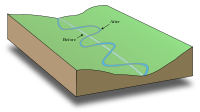
Photo from wikipedia
We consider the evolution of the hydraulic geometry of sand‐bed meandering rivers. We study the difference between the timescale of longitudinal river profile adjustment and that of channel width and… Click to show full abstract
We consider the evolution of the hydraulic geometry of sand‐bed meandering rivers. We study the difference between the timescale of longitudinal river profile adjustment and that of channel width and depth adjustment. We also study the effect of hydrological regime alteration on the evolution of bankfull channel geometry. To achieve this, a previously developed model for the spatiotemporal co‐evolution of bankfull channel characteristics, including bankfull discharge, bankfull width, bankfull depth and down‐channel bed slope, is used. In our modelling framework, flow variability is considered in terms of a specified flow duration curve. Taking advantage of this unique feature, we identify the flow range responsible for long‐term bankfull channel change within the specified flow duration curve. That is, the relative importance of extremely high short‐duration flows compared to moderately high longer duration flows is examined. The Minnesota River, MN, USA, an actively meandering sand‐bed stream, is selected for a case study. The longitudinal profile of the study reach has been in adjustment toward equilibrium since the end of the last glaciation, while its bankfull cross‐section is rapidly widening due to hydrological regime change in the last several decades. We use the model to demonstrate that the timescale for longitudinal channel profile adjustment is much greater than the timescale for cross‐sectional profile adjustment due to a lateral channel shift. We also show that hydrological regime shift is responsible for the recent rapid widening of the Minnesota River. Our analysis suggests that increases in the 5–25% exceedance flows play a more significant role in recent bankfull channel enlargement of the Minnesota River than increase in either the 0.1% exceedance flow or the 90% exceedance flow. © 2020 John Wiley & Sons, Ltd.
Journal Title: Earth Surface Processes and Landforms
Year Published: 2020
Link to full text (if available)
Share on Social Media: Sign Up to like & get
recommendations!